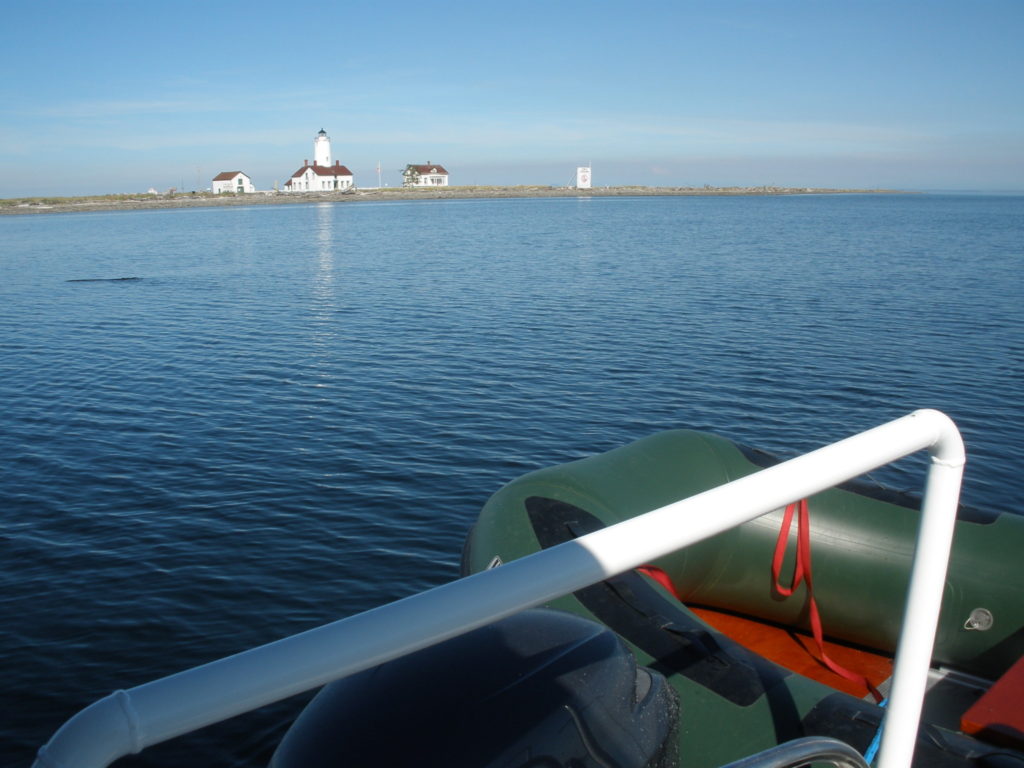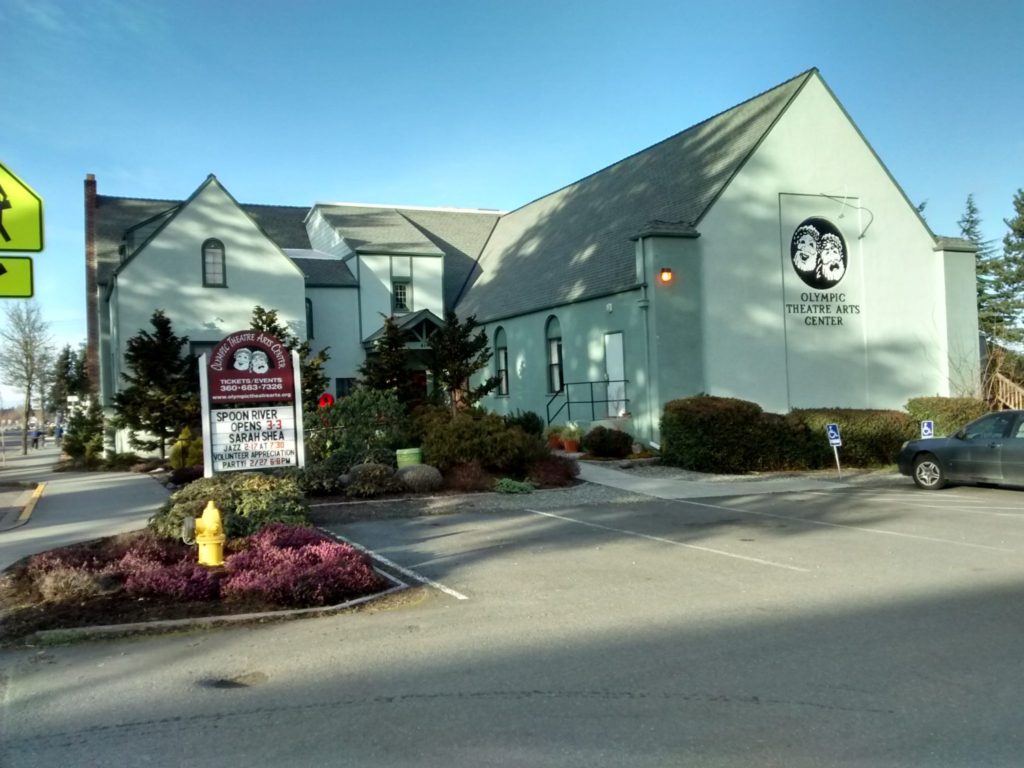
By Dorothy Rice Bennett
When I first moved to Sequim in 2010, I was disappointed that the nearest movie theatre was in Port Angeles, some twenty minutes away. I had lived in Phoenix and San Diego for most of my adult life and always had many movie multiplexes and live theatre venues close around me. What, I questioned, did a person do for entertainment in a small town? Where were all the arts?
Well, I soon found out that the Olympic Peninsula—though sparsely populated by comparison to Seattle and its environs—is far from a cultural wasteland. Indeed, the arts are alive and well in Sequim and on the whole peninsula as well. Compared to the big city, ticket prices are low and easy to obtain. And the talent isn’t to be believed until you experience it for yourself!
Theatre productions
A few months after my arrival, I connected with local theatre, both Readers Theatre+ and Olympic Theatre Arts. I started ushering for OTA, which has a big season each year of five shows performed in the main theatre seating 160 and three shows  performed in the smaller, more flexible “gathering hall.” Ushering allowed me to see all the shows, and I was really impressed with the quality of the performances. I eventually became a member, a house manager, and then served three years on the OTA board. Productions have ranged from the musical I Do! I Do! to the still controversial The Vagina Monologues and Shakespeare’s Twelfth Night. Sequim residents love comedies, so OTA delivers several each year.
performed in the smaller, more flexible “gathering hall.” Ushering allowed me to see all the shows, and I was really impressed with the quality of the performances. I eventually became a member, a house manager, and then served three years on the OTA board. Productions have ranged from the musical I Do! I Do! to the still controversial The Vagina Monologues and Shakespeare’s Twelfth Night. Sequim residents love comedies, so OTA delivers several each year.
The Olympic Theatre Arts Center not only houses OTA’s adult theatre productions and children’s theatre training program, the building also serves as Sequim’s performing arts center. Sequim Ballet, visiting musicians, various choruses, holiday music 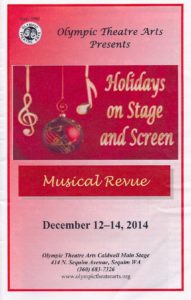 shows, and fund-raising events are performed on its two stages. One of my favorite evenings was a presentation involving four grand pianos on the main stage, all played at the same time by four pianists of different ages. An amazing evening and, of course, the house was full!
shows, and fund-raising events are performed on its two stages. One of my favorite evenings was a presentation involving four grand pianos on the main stage, all played at the same time by four pianists of different ages. An amazing evening and, of course, the house was full!
Beyond the confines of Sequim, friends alerted me to Port Angeles Community Players and another group that did summer musicals, Port Angeles Light Opera Association. I was soon driving to PA to see theatre as well. In the other direction from Sequim, a semi-professional theatre group, Key City Public Theatre, has a long and successful history in Port Townsend.
Sequim High School for more than fifty years has produced a spring musical—filling its large auditorium with audiences delighted by stellar singing and acting, sophisticated stage settings, and amazing costumes. Last year’s Cinderella featured costume changes in front of our eyes that were purely magical! The high school stage is also the scene for a summer musical put on by Ghostlight Productions, run by the Lorentzen family—all talented singers, actors, and musicians. Ghostlight was responsible recently for the first West Coast production of the Tony Award winning musical Titanic.
Orchestras and choruses
Port Angeles has an excellent symphony orchestra. The full orchestra, and the smaller chamber orchestra, perform both in PA and in Sequim during their annual season. A couple summers ago, the PA Symphony joined with the Port Angeles and Sequim High School choirs for a “Pops & Picnic”  performance at the Sequim Boys and Girls Club. Dinner was served before the concert, and the audience gave the music a rousing reception. In a gymnasium setting, the orchestra disappeared behind the chorus members, but we could hear the musicians just fine!
performance at the Sequim Boys and Girls Club. Dinner was served before the concert, and the audience gave the music a rousing reception. In a gymnasium setting, the orchestra disappeared behind the chorus members, but we could hear the musicians just fine!
Speaking of music, there is no end of musical opportunities in Sequim and the surrounding areas. The Peninsula Singers, a volunteer group with a thirty-year history, does two main programs each year, one before Christmas and a second close to Easter in the spring. The group performs classical, operatic, Broadway, film, and folk musical numbers. Sequim also has a community orchestra and a city band.
In Port Angeles there is the North West Women’s Chorale, which has been performing on the Peninsula for the past several years. In Sequim, there is the Olympic Peninsula Men’s Chorus, which offers barbershop singing; the group also has a quartet, “No Batteries Required.”
The Chamber Music Society of Port Townsend is another excellent local group that focuses on talented young artists and offers training sessions in the summer months.. I have seen them perform at the Quimper Universalist Unitarian Church in PT. 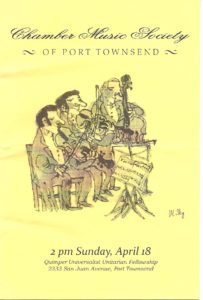 There is also the Port Townsend Community Orchestra, founded in 1987, which presents concerts during the year.
There is also the Port Townsend Community Orchestra, founded in 1987, which presents concerts during the year.
Festival and series events
Every summer for several days, visitors and locals enjoy the Olympic Music Festival, which features world class chamber musicians performing a variety of classical music pieces. Once centered in a barn in Chimacum, the event has been recently transferred to Fort Worden in Port Townsend. In 2107, it will be held July 15 and 16 and again August 12 through September 10 in the Wheeler Theater at the fort.
St. Luke’s Episcopal Church in Sequim for several years has offered a monthly program called “Music Live With Lunch.” Area musicians perform half-hour concerts in the church sanctuary, followed by a meal, prepared by church volunteers, in the community hall. Proceeds from the event benefit local charities. The monthly program is very popular, drawing large audiences and excellent local musicians: singers, pianists, guitarists, cellists, and violinists. Patrons have been fortunate to see amazing talent, including the young violinist Kate Powers who first performed when she was thirteen, having begun violin studies at age ten. Now ready for college, Powers plays both classical violin—she has already appeared with the Port Angeles Symphony—and fiddle. She is an incredible young talent!
Speaking of the fiddle, the Washington State Old Time Fiddlers Association, Section 13, meets in Sequim at the Grange Hall on the prairie side of town. Each month, on the second Saturday, adult and young fiddlers tune up to present an afternoon concert open to the public free of charge. If you enjoy fiddle music, the Grange is the place to be.
I know I haven’t mentioned all the performers and venues on the Olympic Peninsula, but these are ones I have personally experienced. In any given week, there is always a performance somewhere. On some weekends, there are so many events it is not possible to see them all. Consequently, rural although we are, we do not lack for entertainment!
For more information on these groups, their specific locations, and their performances, please see the following:
http://olympictheatrearts.org/OTA/
http://www.porttownsendorchestra.org/orchestra/
http://centrum.org/port-townsend-chamber-music-festival/
http://portangelessymphony.org
http://ghostlight-productions.com
http://www.sequimcommunityorchestra.org
http://www.olympicmusicfestival.org
http://www.pacommunityplayers.com
http://www.keycitypublictheatre.org
http://www.peninsulasingers.org/PeninsulaSingers/first.html
http://www.nwwomenschorale.org
https://www.facebook.com/SHS.Drama.Department/
http://www.stlukesparish.net/serving/music-live/


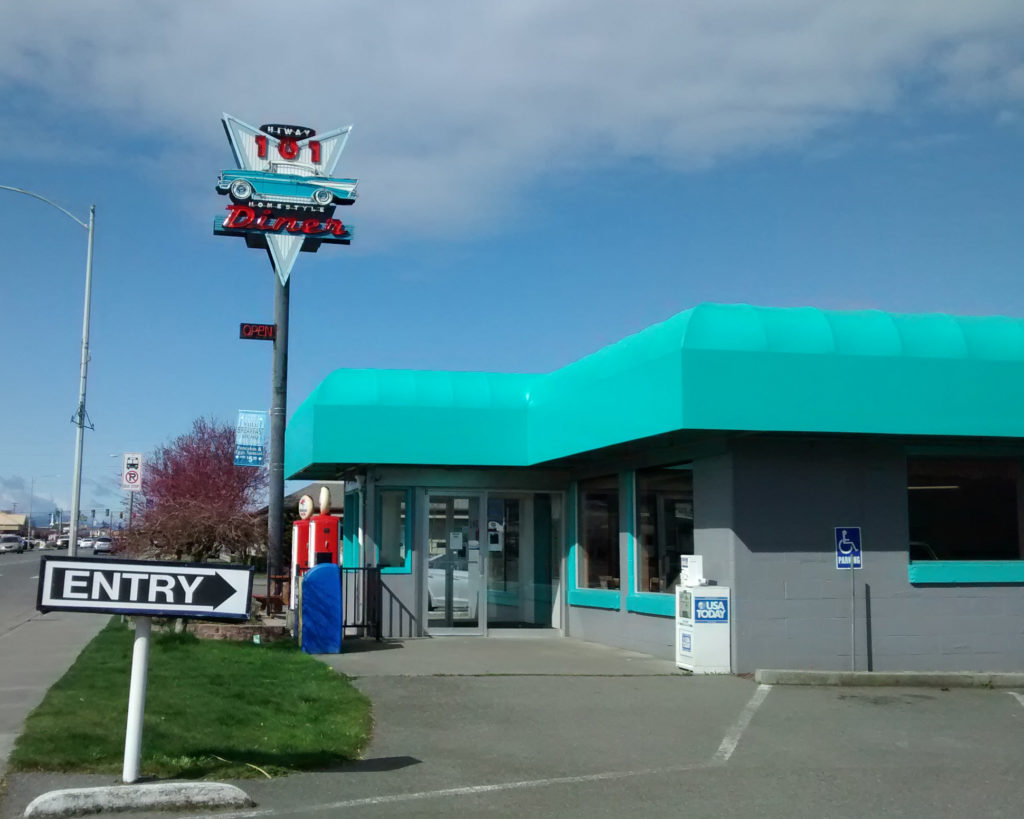
 hose I’ve mentioned here do have 4.5 to 5 stars on internet review sites.
hose I’ve mentioned here do have 4.5 to 5 stars on internet review sites. the movie star posters on the wall. Food is tasty and down home, the way it was cooked in the 50s. The Sunshine Café, 145 W. Washington, is another family-owned eatery with a long history, an informal setting, and good food and service. Like The Oak Table, it is open for breakfast and lunch only, with some variation in days, hours, according to the season. Of course Black Bear Diner, Applebee’s and IHOP all serve breakfast and have their own following among locals and travelers.
the movie star posters on the wall. Food is tasty and down home, the way it was cooked in the 50s. The Sunshine Café, 145 W. Washington, is another family-owned eatery with a long history, an informal setting, and good food and service. Like The Oak Table, it is open for breakfast and lunch only, with some variation in days, hours, according to the season. Of course Black Bear Diner, Applebee’s and IHOP all serve breakfast and have their own following among locals and travelers.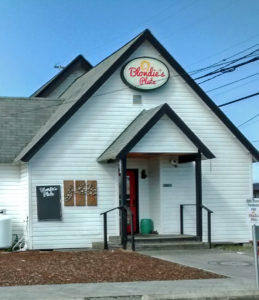 If you are a little more adventuresome, you can try Blondie’s Plate, 134 S. 2nd St., and Emerald Northwest Grill and Public House, 179 W. Washington St., both of which offer different dining choices. Oasis Bar & Grill, 301 E. Washington, has specials several nights each week. Folks rave about their steaks and fries and juicy hamburgers!
If you are a little more adventuresome, you can try Blondie’s Plate, 134 S. 2nd St., and Emerald Northwest Grill and Public House, 179 W. Washington St., both of which offer different dining choices. Oasis Bar & Grill, 301 E. Washington, has specials several nights each week. Folks rave about their steaks and fries and juicy hamburgers!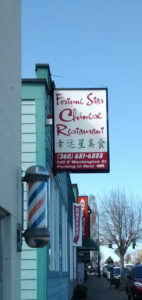
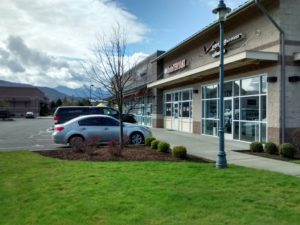 at 1243 W. Washington. Very simple and set up for lots of take-out. I found this store at 6 p.m. with every seat taken and a line to the front door. The aroma of cooking food filled the parking lot—drawing all of us in!
at 1243 W. Washington. Very simple and set up for lots of take-out. I found this store at 6 p.m. with every seat taken and a line to the front door. The aroma of cooking food filled the parking lot—drawing all of us in!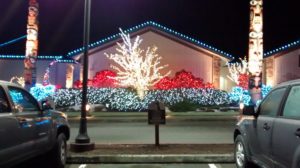 edars of Dungeness Golf Resort at 1965 Woodcock Rd. out on the prairie. Stymie’s and the Double Eagle Restaurant at the golf resort share a kitchen and between them serve three meals a day and provide bar service. These Native American properties offer quality food, discounts with free membership in the casino’s slot club, and are among the most popular places to eat in Sequim.
edars of Dungeness Golf Resort at 1965 Woodcock Rd. out on the prairie. Stymie’s and the Double Eagle Restaurant at the golf resort share a kitchen and between them serve three meals a day and provide bar service. These Native American properties offer quality food, discounts with free membership in the casino’s slot club, and are among the most popular places to eat in Sequim.

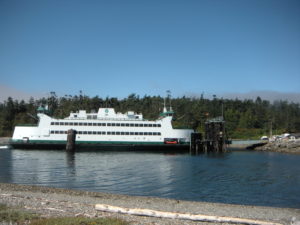 east on the 101 highway to Discovery Bay, turn left onto the state 20 highway headed to Port Townsend. Just south of the main part of town, we see the ferry docks on our right and line up as instructed to wait for the next ferry. As part of the Washington State Ferry system, the Pt. Townsend to Coupeville ferry run is made on a smaller vessel—which is the reason for reservations. Still space for quite a few cars, SUVs and trucks on board and a comfortable passenger cabin a deck above with outdoor spots for photo ops.
east on the 101 highway to Discovery Bay, turn left onto the state 20 highway headed to Port Townsend. Just south of the main part of town, we see the ferry docks on our right and line up as instructed to wait for the next ferry. As part of the Washington State Ferry system, the Pt. Townsend to Coupeville ferry run is made on a smaller vessel—which is the reason for reservations. Still space for quite a few cars, SUVs and trucks on board and a comfortable passenger cabin a deck above with outdoor spots for photo ops.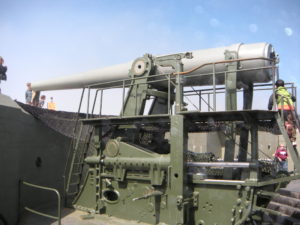 batteries, to protect the Puget Sound against military attack. At Fort Casey, there are several batteries available to be explored; these were used by soldiers being trained at this location during World War I and II. Fort Casey houses rare 10-inch guns mounted and on display. The park itself contains nearly 1,000 acres with considerable saltwater shoreline. Campsites and picnicking are available; the one-time military barracks are now used as conference facilities. There are beautiful views for photographers, including snow covered Mt. Baker to the north.
batteries, to protect the Puget Sound against military attack. At Fort Casey, there are several batteries available to be explored; these were used by soldiers being trained at this location during World War I and II. Fort Casey houses rare 10-inch guns mounted and on display. The park itself contains nearly 1,000 acres with considerable saltwater shoreline. Campsites and picnicking are available; the one-time military barracks are now used as conference facilities. There are beautiful views for photographers, including snow covered Mt. Baker to the north.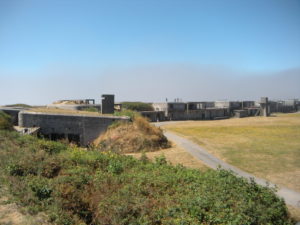 steps and grassy knolls to climb—I remember because my apricot toy poodle didn’t like the steps and I had to find another way to reach the batteries!). You can get up close and personal to the guns. There is also a hiking trail that runs along the shoreline through the fort. Children and dogs have open spaces to enjoy; there is a spot for kite flying and a designated remote-control glider area. Guided tours of the gun batteries are available on weekends during the summer months; information is posted at a kiosk near Battery Worth.
steps and grassy knolls to climb—I remember because my apricot toy poodle didn’t like the steps and I had to find another way to reach the batteries!). You can get up close and personal to the guns. There is also a hiking trail that runs along the shoreline through the fort. Children and dogs have open spaces to enjoy; there is a spot for kite flying and a designated remote-control glider area. Guided tours of the gun batteries are available on weekends during the summer months; information is posted at a kiosk near Battery Worth.


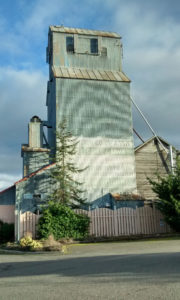 own, and the grain elevator was built next to the tracks for pretty obvious reasons. The building
own, and the grain elevator was built next to the tracks for pretty obvious reasons. The building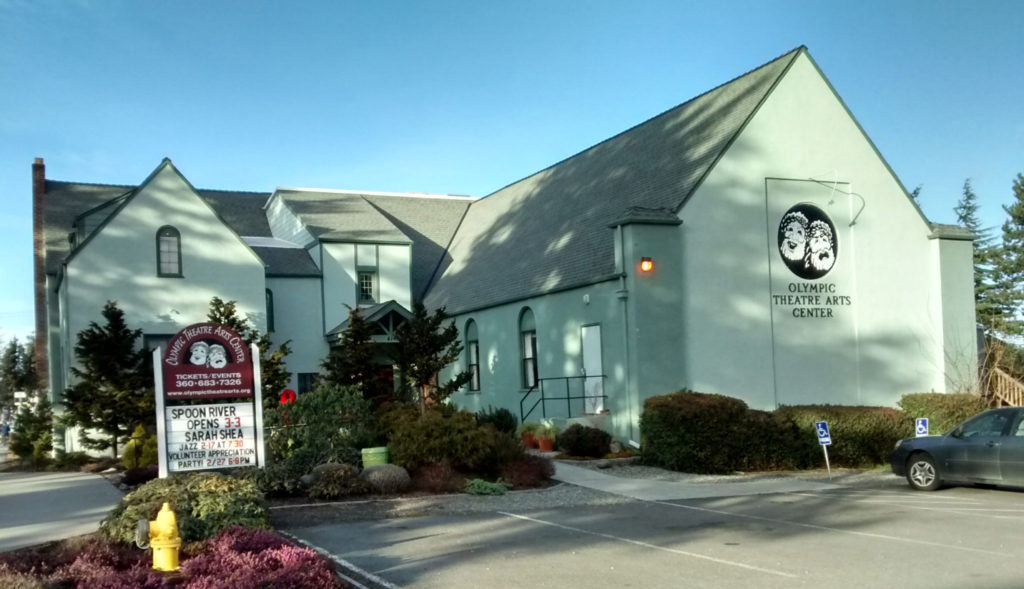
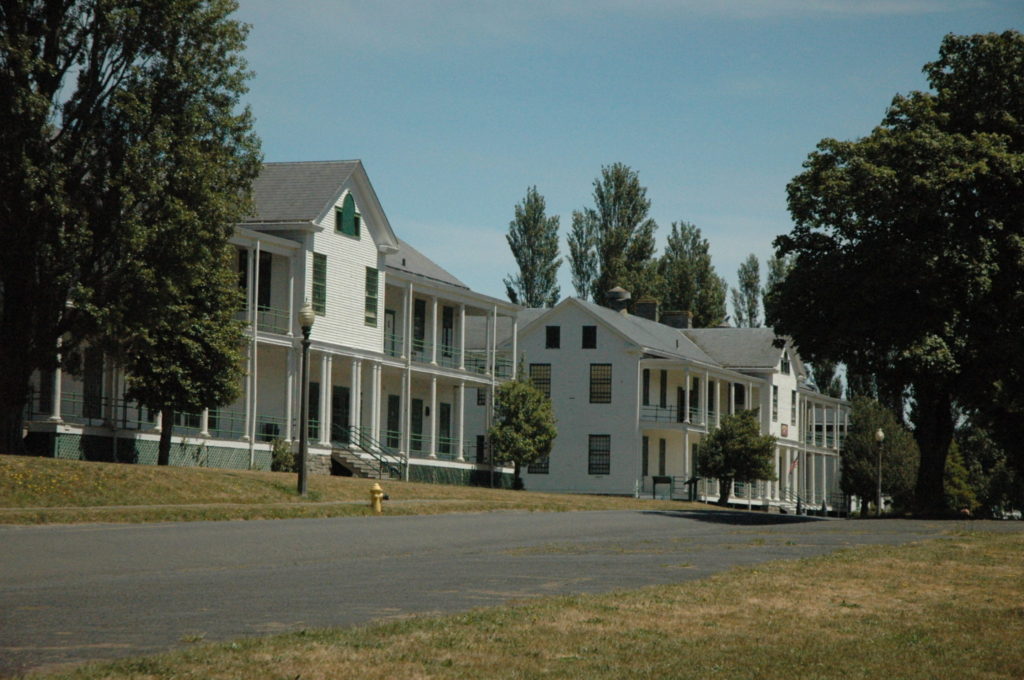
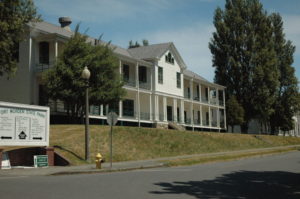 summer camps, music festivals, restaurants, and rentals for visitors. Several of the main historic buildings are laid out in rows on both sides of a broad common grass field—a parade ground where troops once assembled and marched. Photo ops abound, and walking around these buildings offers visitors a unique sense of history. My personal favorite spot is the fort’s gift shop (since I am a T-shirt aficionado). Photos taken here for this blog are courtesy of Connie, who is good with a camera! We were picnicking that day and found a lovely shaded spot with a picnic table just off the main street—thanks to advice from gift shop staff.
summer camps, music festivals, restaurants, and rentals for visitors. Several of the main historic buildings are laid out in rows on both sides of a broad common grass field—a parade ground where troops once assembled and marched. Photo ops abound, and walking around these buildings offers visitors a unique sense of history. My personal favorite spot is the fort’s gift shop (since I am a T-shirt aficionado). Photos taken here for this blog are courtesy of Connie, who is good with a camera! We were picnicking that day and found a lovely shaded spot with a picnic table just off the main street—thanks to advice from gift shop staff.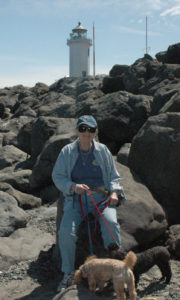 exist from many directions. And the rocky beach (everything from pebbles to boulders) is an attraction of its own.
exist from many directions. And the rocky beach (everything from pebbles to boulders) is an attraction of its own.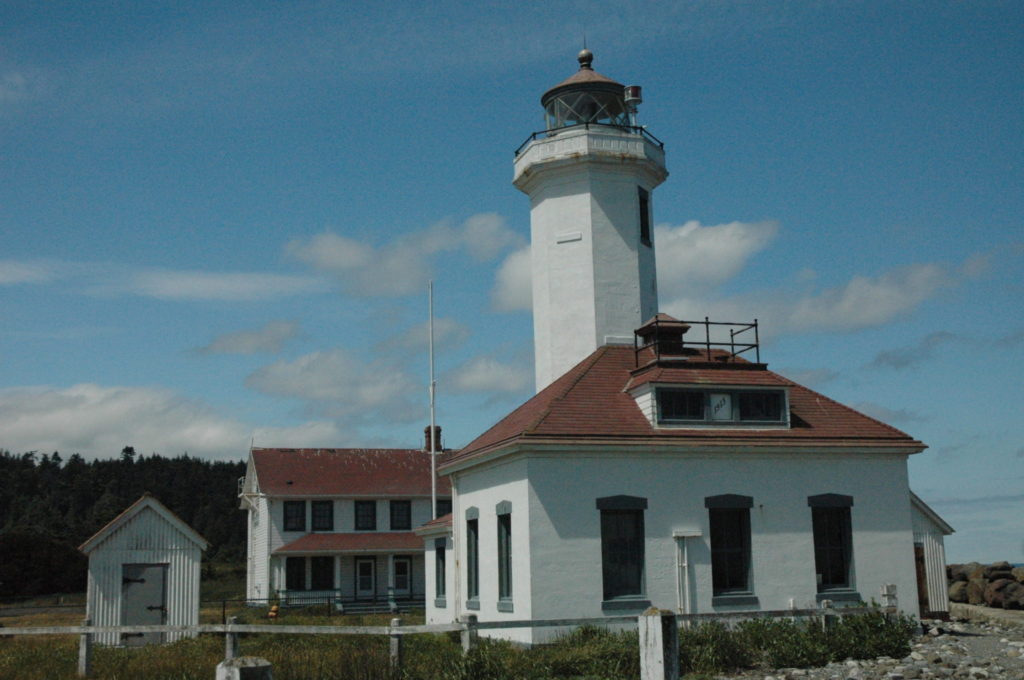
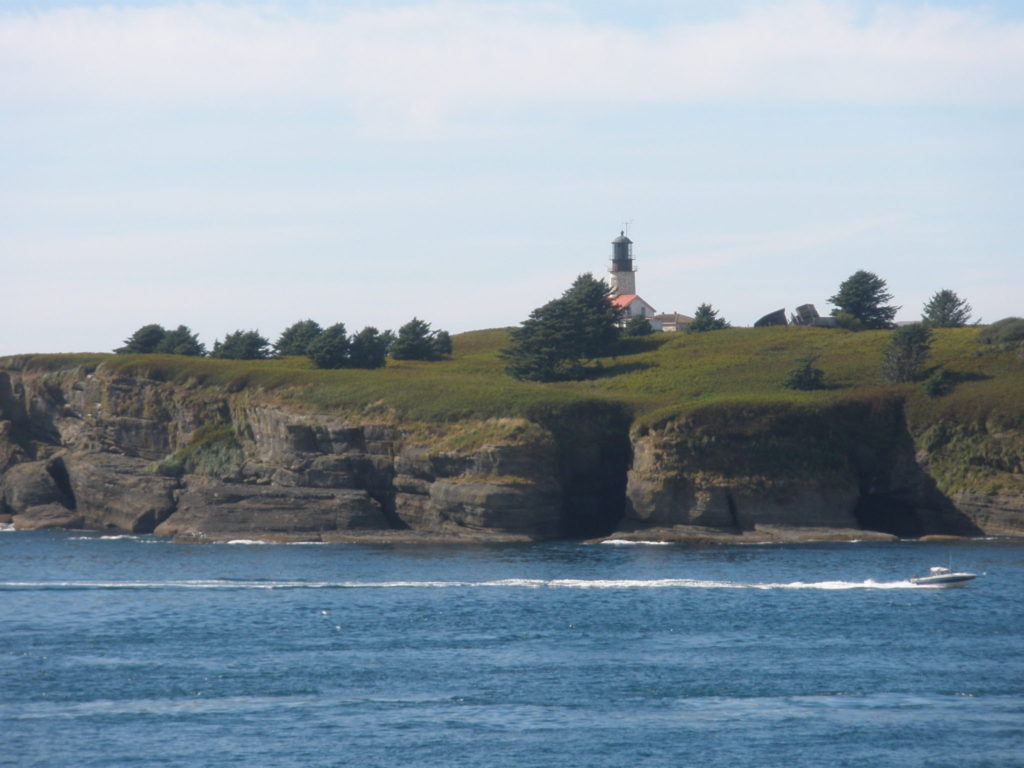
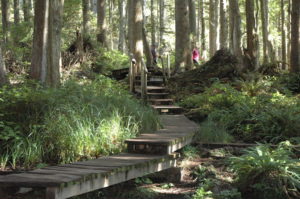 toward Clallam Bay, Sekiu, and then Neah Bay. Or, you can stay on the 101 past Lake Crescent and then turn north on highway 113 and follow it until that road meets the 112 and then continue west to Neah Bay. No matter how you do it, it is a fairly long drive but has scenic moments. From Clallam Bay westward, you are often driving along the Straits of Juan de Fuca, always beautiful no matter the weather.
toward Clallam Bay, Sekiu, and then Neah Bay. Or, you can stay on the 101 past Lake Crescent and then turn north on highway 113 and follow it until that road meets the 112 and then continue west to Neah Bay. No matter how you do it, it is a fairly long drive but has scenic moments. From Clallam Bay westward, you are often driving along the Straits of Juan de Fuca, always beautiful no matter the weather. f green foliage are luminous. There are hollowed out trunks that you can step into. There is much to photograph. I’ll repeat: There is much to
f green foliage are luminous. There are hollowed out trunks that you can step into. There is much to photograph. I’ll repeat: There is much to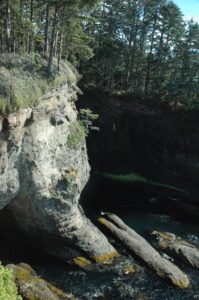 places to your left and right with lookouts. These have benches, railings, and breathtaking views of caves, rugged bluffs, crashing waves, shore birds in their habitat, turquoise waters, and monoliths off the shoreline.
places to your left and right with lookouts. These have benches, railings, and breathtaking views of caves, rugged bluffs, crashing waves, shore birds in their habitat, turquoise waters, and monoliths off the shoreline.
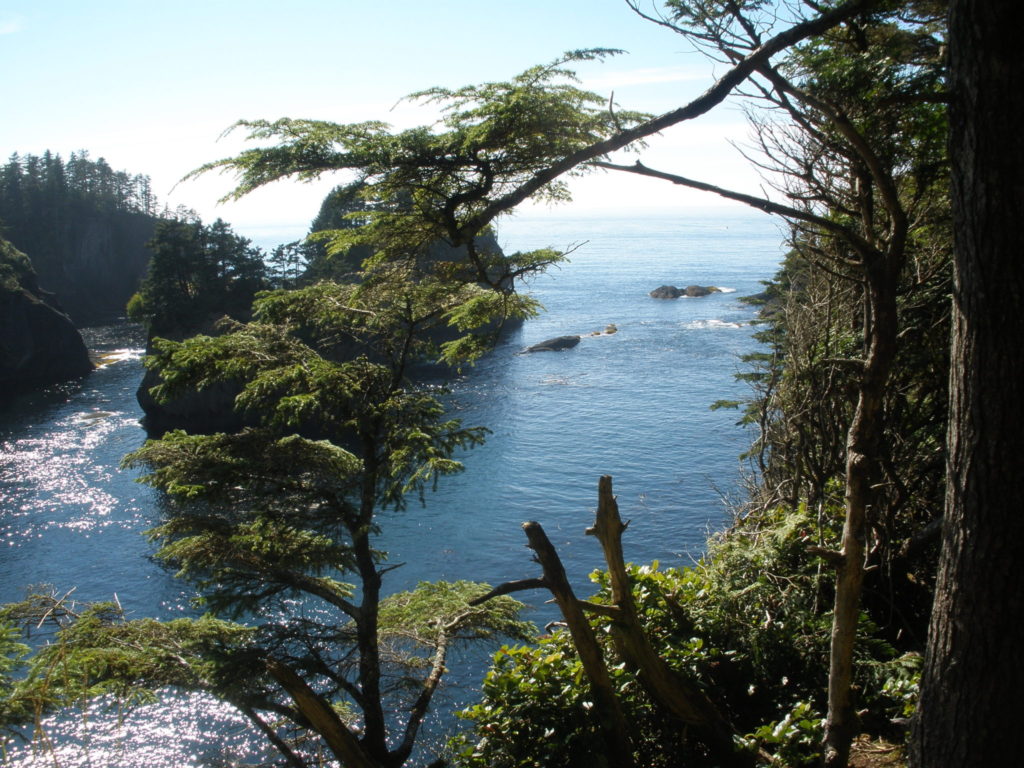

 out with our two poodles one day in June 2013. We had lunch along with leashes and cameras and needed them all.
out with our two poodles one day in June 2013. We had lunch along with leashes and cameras and needed them all.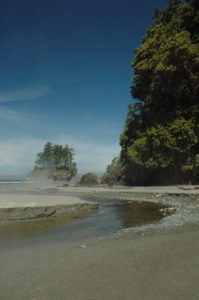 into the Straits. The day we visited, there was a mist hanging over the creek water. It was beautiful and eerie, and we have never seen that mist again during our many visits to the area. Our cameras came out, and we took a lot of pictures of the creek, the bluff to our right (which is part of the main park above), the monolith ahead and to our left (covered with trees on the top) and the rocky coastline that could be walked by the sure of foot.
into the Straits. The day we visited, there was a mist hanging over the creek water. It was beautiful and eerie, and we have never seen that mist again during our many visits to the area. Our cameras came out, and we took a lot of pictures of the creek, the bluff to our right (which is part of the main park above), the monolith ahead and to our left (covered with trees on the top) and the rocky coastline that could be walked by the sure of foot.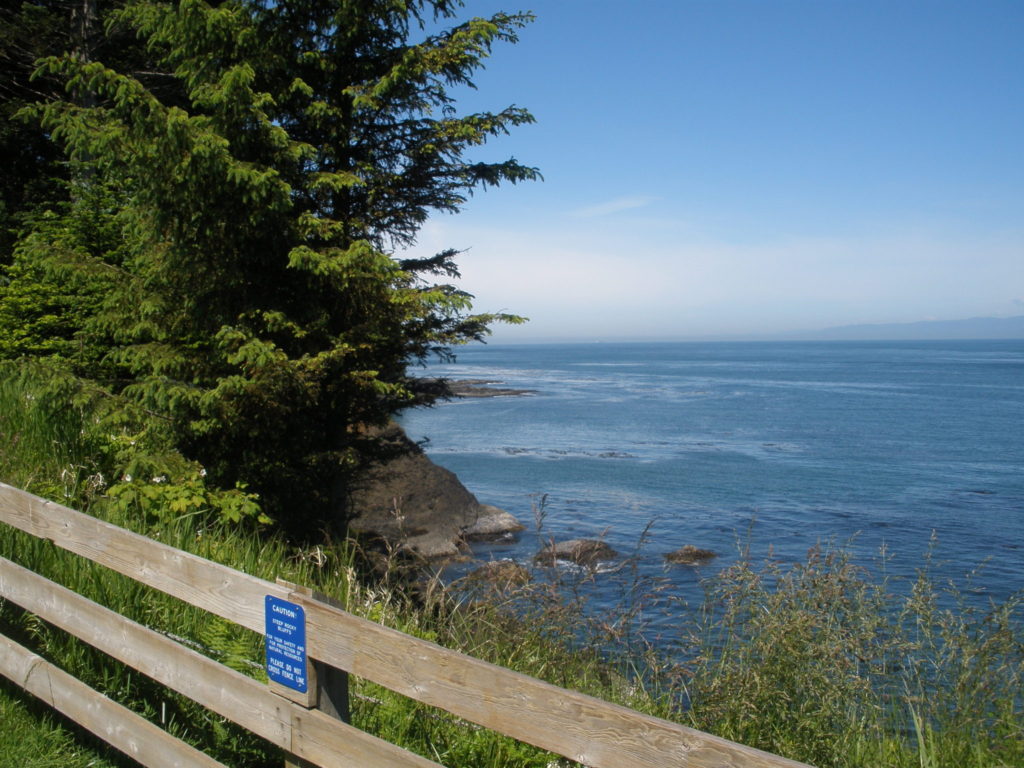
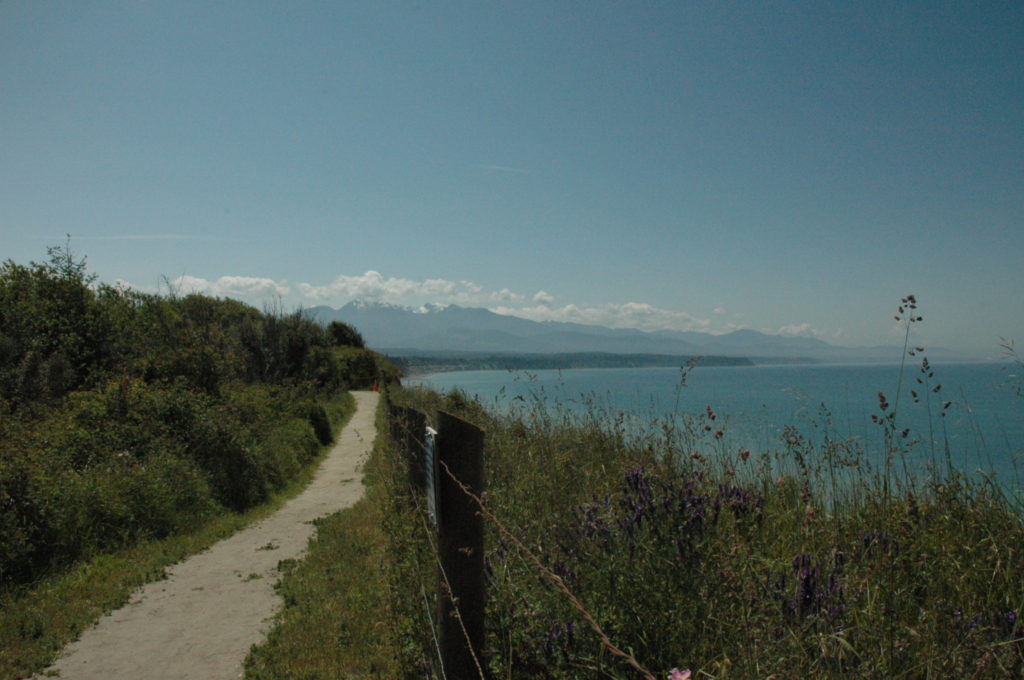
 an de Fuca. On that land mass there are roads, trails, parking areas, and spots for camping and picnicking. Most of this upper area is open to dogs on leashes. It includes a lengthy trail overlooking the Washington coastline with views to the west to Port Angeles, the Olympic mountains in the background, and Vancouver Island and Victoria, B.C., to the north.
an de Fuca. On that land mass there are roads, trails, parking areas, and spots for camping and picnicking. Most of this upper area is open to dogs on leashes. It includes a lengthy trail overlooking the Washington coastline with views to the west to Port Angeles, the Olympic mountains in the background, and Vancouver Island and Victoria, B.C., to the north. owntown Sequim, the Dungeness (as it is locally called) is an amazing community asset. Open year round in the daytime, it is a great place for a dog walk or a picnic, and there are enough things to do to fill an entire afternoon, when you bring along binoculars and/or a camera. Maybe a walking stick.
owntown Sequim, the Dungeness (as it is locally called) is an amazing community asset. Open year round in the daytime, it is a great place for a dog walk or a picnic, and there are enough things to do to fill an entire afternoon, when you bring along binoculars and/or a camera. Maybe a walking stick.

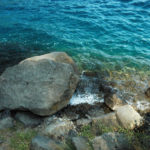 days, Lake Crescent remains amazingly quiet. Kayaks, canoes, and sailboats can be seen out on the water, and at some places an occasional small motorboat appears moving along. But stillness reigns.
days, Lake Crescent remains amazingly quiet. Kayaks, canoes, and sailboats can be seen out on the water, and at some places an occasional small motorboat appears moving along. But stillness reigns. My friends and I had a lovely buffet Thanksgiving dinner there this year. The food and service were great, and we didn’t let a little bit of rain ruin our fun.
My friends and I had a lovely buffet Thanksgiving dinner there this year. The food and service were great, and we didn’t let a little bit of rain ruin our fun.
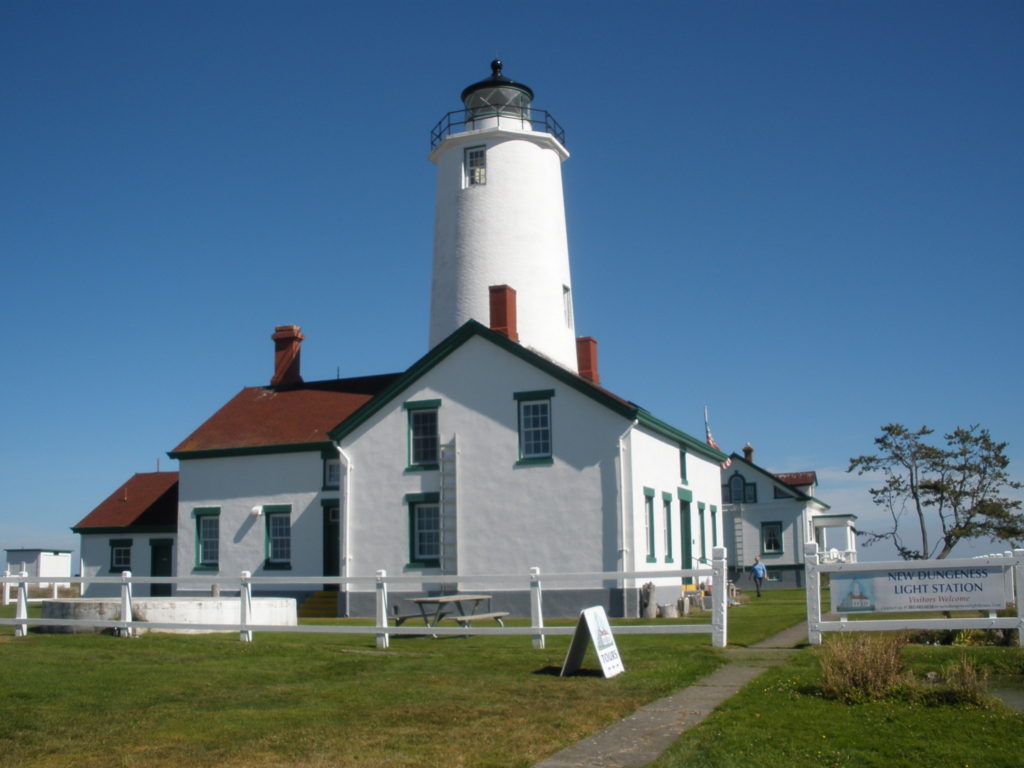
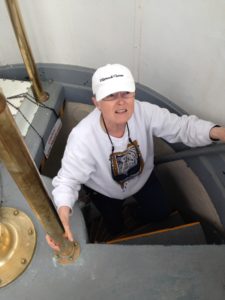 Tours of the museum and tower are available from 9 to 5 daily. Climbing the seventy-four steps to the top of the tower was a bit of a challenge for me but offered a marvelous view of the Dungeness Refuge, the Straits, and Canada. Outside, at ground level, I was impressed by the absence of noise. I cannot imagine a more peaceful setting!
Tours of the museum and tower are available from 9 to 5 daily. Climbing the seventy-four steps to the top of the tower was a bit of a challenge for me but offered a marvelous view of the Dungeness Refuge, the Straits, and Canada. Outside, at ground level, I was impressed by the absence of noise. I cannot imagine a more peaceful setting!